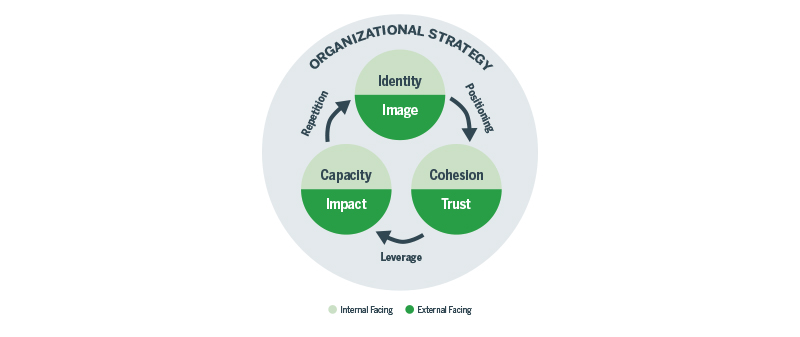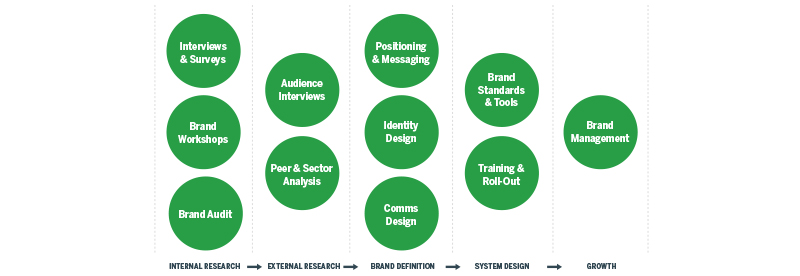Seeking new ways to increase their impact, leading nonprofits increasingly are taking a broader view of the strategic role their brand can play in driving long-term social change. In this new view, a nonprofit’s brand is much more than a tool for communications or fundraising. It is critical to organizational strategy — making that strategy tangible through a system of designed experiences that express the ideas and values the organization represents.
Such a view marks a significant departure from older, more limited perceptions of the role of a nonprofit’s brand in advancing social impact. In this new paradigm, a brand must embody critical elements such as social innovation and design thinking (as exemplified by the work of design firms such as IDEO). This view also embraces the ability of a brand to shape conversations, strengthen relationships, and increase an organization’s effectiveness. This line of thinking is best articulated in the work of Harvard professor Nathalie Laidler-Kylander and Christopher Stone — and detailed in their book The Brand IDEA: Managing Nonprofit Brands with Integrity, Democracy, and Affinity.
A New Approach to Leveraging Social Impact
Among its many insights The Brand IDEA suggests a new role for “brand” within the nonprofit organization — a role in which it is both driven by, and acts as a primary driver of, organizational strategy, exerting influence and commanding mind-share, both internally and externally, to create a virtuous cycle that strengthens and reinforces itself with each success.
Visualized, what Kylander and Stone title the “Role of Brand Cycle” in a nonprofit looks something like this:

As explained in more detail in this video, it’s easy to see why, for many nonprofits, “brand” is their most valuable asset.
Managing Your Organization’s Brand Value
Of course, a nonprofit doesn’t receive the benefits of a strong brand along with its 501(c)(3) status. Those benefits are earned through a willingness to commit to and cultivate an organizational culture that prioritizes the development and nurturing of a clearly defined brand. And harnessing the potential that’s stored within your brand requires a strategic framework for thinking about, creating, and managing the different ways the brand is understood and expressed — internally as well as externally. It requires the cohesion (to use Laidler-Kylander’s phrase) needed to create organizational alignment and the consistency that all brands must embody in order to create trust and foster loyalty (something I’ve written about here).
Branding is that framework. At Constructive, we think of it as a process in which strategic and creative thinking are applied to the development of systems and tools that can help an organization bridge the gap between the place a brand occupies in the minds of its audience and the sights and sounds that make it tangible in the real world — a translation of organizational strategy into experiences.
Like any framework, branding consists of key foundational elements that work together to create a toolbox that a nonprofit can draw upon to advance its mission and increase its impact. It’s perhaps most easily understood when broken down into three parts. The first two, “brand language” (what you want to say) and “brand design” (how those messages are delivered), are used to create “brand experiences” (what happens) that resonate with your audiences.
Design firms like Constructive spend a great deal of time and energy helping organizations create purpose and alignment across the things they want to say, how they present themselves, and the interactions that follow as a result. The overarching goal is to deliver meaningful brand experiences that are rooted in deeply held values, aligned with organizational strategy, and put in direct service of your mission.
Consistently Exceptional Brands
The secret of exceptional brands is perhaps best captured by Aristotle’s famous saying: “We are what we repeatedly do. Excellence, therefore, is not an act, but a habit.” Consistency is not only the cornerstone of exceptional performance, it is the key to building trust. People who are asked to engage in a relationship – whether it’s with another individual or with a brand – want to know what they can expect to receive in return. And because people crave consistency, they want to be assured that their expectations will be consistently met. When they aren’t, our confidence and trust in the organization invariably is eroded.
When it comes to nonprofit branding, being clear about what your organization stands for and why it matters, designing experiences that meet (or exceed) the needs and expectations of your audiences, and consistently delivering on your promises is the surest way to strengthen your relationships, increase your effectiveness, and, ultimately, generate greater impact.
But as Aristotle suggests, achieving brand consistency doesn’t happen by accident. It is borne out of a deliberate process designed to create predictable results as well as a framework for managing those results. What does that process look like and how does it help translate strategy (and a host of intangibles) into a valuable asset that helps a nonprofit consistently execute against its organizational strategy?
Different branding and design firms will approach things differently, but ultimately any truly effective branding process is a variation on a theme. The approach we’ve developed at Constructive over the years is designed to help us and our clients reach a collective understanding of the internal and external dynamics that shape the world in which the organization operates and then translate that understanding into a system and tools that can be employed to create consistent brand experiences. It’s a collaborative process that, while perhaps not as neat and linear as the following diagram suggests, has five primary phases:

Phases 1 and 2 are dedicated to quantitative and qualitative research and discovery. Familiar activities such as stakeholder interviews, SWOT analyses, and audits provide clients and the design firm with the necessary context to develop an effective strategy and compelling creative.
As the design firm and client move forward in the process, they draw on what has been learned during the research and discovery phase to define the brand experience and create messaging and collateral materials that embody the organization’s values.
Systems thinking is the next step in the process — codifying the visual, verbal, and experiential elements of the brand into guidelines, tools, and training that turn branding into an organizational asset that can be shared and implemented consistently by all those entrusted with representing and stewarding the brand.
Last but not least, the process, which is grounded in foundational thinking, must remain open to change as the organization evolves over time. By clearly defining what the brand experience sounds, looks, and feels like, a nonprofit can make more informed decisions about what to add and subtract from its branding as the organization itself changes.
A version of this article originally appeared on Philanthropy News Digest in Constructive Founder, Matt Schwartz‘s Cause-Driven Design® column.





